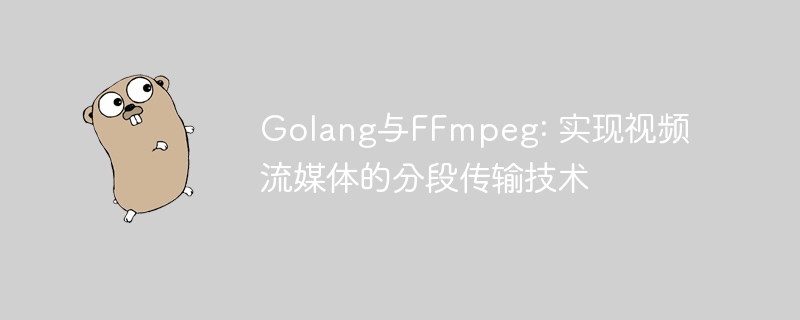Home >Backend Development >Golang >Golang and FFmpeg: Implementing segmented transmission technology for video streaming
Golang and FFmpeg: Implementing segmented transmission technology for video streaming
- 王林Original
- 2023-09-28 12:07:491599browse

Golang and FFmpeg: Implement segmented transmission technology for video streaming
Abstract:
With the rapid development of the Internet and the popularity of high-definition videos, video streaming Media has become an important part of user experience. Segmented transmission technology plays a crucial role when implementing video streaming. This article introduces how to use Golang and FFmpeg to implement segmented transmission of video streaming media, and provides specific code examples.
1. Introduction
Segmented transmission technology refers to the technology of dividing a large file or a continuous data stream into multiple small files or data packets for transmission. For video streaming media, segmented transmission technology can significantly improve transmission efficiency and user experience. In traditional video streaming, video data is split into fixed-size fragments and then transmitted to the client one by one through the network. The client can request and play these fragments one by one as needed to achieve a seamless video playback experience.
2. Use Golang and FFmpeg to implement segmented transmission of video streaming
Golang is an emerging and powerful programming language suitable for developing high-performance distributed and concurrent applications. FFmpeg is a widely used open source multimedia framework that provides rich functions for processing audio, video and streaming media data. Combining Golang and FFmpeg can achieve segmented transmission of video streaming media.
In this example, we will use Golang to write a simple HTTP server and use FFmpeg to split the video file into multiple slices. The following is a simple code example:
package main
import (
"fmt"
"net/http"
"os/exec"
)
func handleVideoStreaming(w http.ResponseWriter, r *http.Request) {
cmd := exec.Command("ffmpeg", "-i", "input.mp4", "-c:v", "copy", "-map", "0", "-f", "segment", "-segment_time", "10", "-segment_list", "playlist.m3u8", "-segment_format", "mpegts", "output%d.ts")
err := cmd.Run()
if err != nil {
fmt.Println("视频切分出错:", err)
return
}
http.ServeFile(w, r, "playlist.m3u8")
}
func main() {
http.HandleFunc("/video", handleVideoStreaming)
http.ListenAndServe(":8080", nil)
}In the example, we first use FFmpeg to split the input video file (input.mp4) into 10-second segments, and save the segment information in the playlist .m3u8 file. Then use Golang's HTTP library to transfer the m3u8 file to the client.
3. Experimental results and analysis
Through the above example code, we can realize segmented transmission of video streaming media. In the actual test, we can open the browser and enter http://localhost:8080/video to access the segmented video streaming media. By looking at the browser's developer tools, we can see that the video streaming request is divided into multiple shards and transmitted in sequence.
By combining Golang and FFmpeg to implement segmented transmission technology for video streaming, we can improve the efficiency and user experience of video transmission. In addition, Golang's high performance and concurrency features can ensure the stability and reliability of video streaming transmission.
Conclusion:
This article introduces how to use Golang and FFmpeg to implement segmented transmission technology for video streaming, and provides specific code examples. Through segmented transmission technology, we can improve the efficiency of video transmission, allowing users to better enjoy the viewing experience of high-definition videos. In the future, with the continuous development of the Internet, segmented transmission technology for video streaming will become more important and common.
The above is the detailed content of Golang and FFmpeg: Implementing segmented transmission technology for video streaming. For more information, please follow other related articles on the PHP Chinese website!

